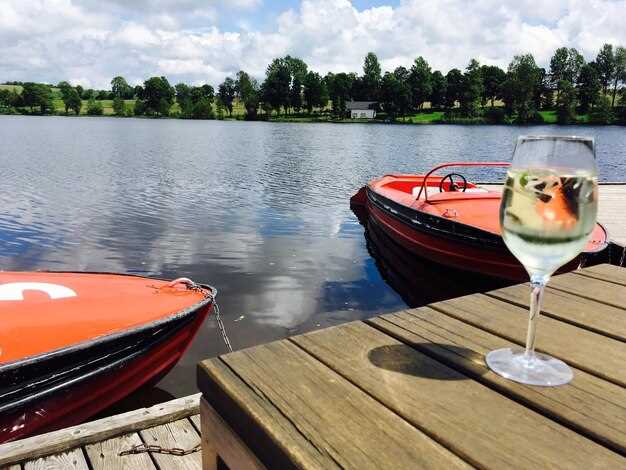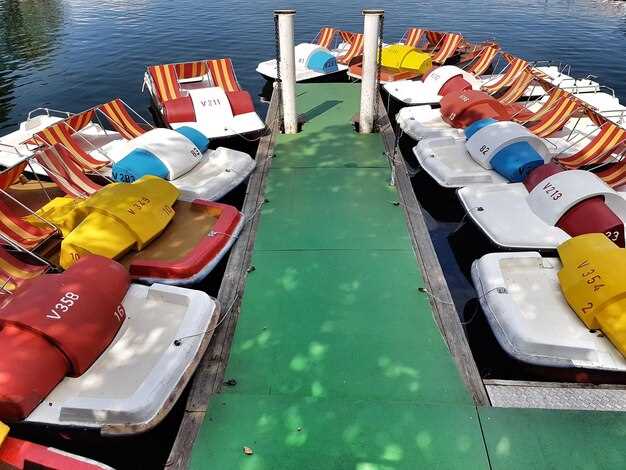Book ahead for your next group outing to secure pontoons with the best availability and safe, well-maintained gear.
Most pontoons in mid-range fleets run 20–24 feet and host 6–12 guests, with 90–150 HP engines and a shallow keel that keeps the deck stable when you circle near the shore. Expect built-in life jackets in sizes for kids and adults, plus storage for a cooler, towels, and sunscreen, and weather-ready canopies to extend your day.
To keep everyone comfortable, ensure the craft is properly inspected before departure; the staff will guide you through a quick safety briefing and a simple map of the next hours, noting necessary equipment such as a throwable float and a first-aid kit. Always check which gear is used and that it is in working order to keep the day safe for everyone on board.
Over the years, weve found that the most flexible deals appear on weekdays, and that booking 4–6 weeks in advance ensures the next window is open. Forget the myth that you need a full-day charter to enjoy water time; a well-planned 3–4 hour outing around a couple of coves can deliver a complete experience, especially when you choose a model with shade and a simple swim ladder. Another tip: check the forecast before you depart and adjust your route for any sudden wind shifts, as part of your day on the water.
There are several kinds of layouts to choose from, including standard decks, three-seat sections for larger groups, and models with raised lounges or sun decks. Most fleets provide towels, a small cooler, and a ladder for easy water access, plus optional gear like fishing tackle or Bluetooth speakers. Check the availability at your chosen shore and compare add-ons to maximize value for your trip around town, or plan another short outing later in the year.
Discover options that fit your group size and budget, then lock in your plan with the staff so you can enjoy a smooth escape around nearby coves and shorelines–returning to the dock before dark, safe and satisfied.
Practical Guide to Affordable Family Pontoon Rentals
Choose a weekday with strong availability to secure a lower rate and calmer schedules on the water.
There is much to weigh, but careful prep pays off.
Right-sized craft matter: select a watercraft with capacity for your family and a few guests, with a sandy deck and shady spots for rest. Check the whole capacity and weight limits to avoid surprises when you pull into a quiet cove.
Residency and license: verify if the marina requires proof of residency or a local license. Have copies ready; this saves time at check-in and keeps your day moving.
Must-have safety: every rider wears a life jacket; the operator should brief the group on zones, speed, and anchored resting spots. Ensure the team can operate the craft and answer questions.
Plenty of options: compare fleet sizes, cabin protection, and extras. Some providers include plenty of gear like snorkel sets or fishing rods; extratheyre charges may apply for add-ons–check the total before you commit.
Plan an exploring route: prior to departure, map out beaches, wild coves, and dolphins you may spot along the coast. Look for sandy banks for picnics and shallow flats for safe swimming; plan a few view stops to capture memorable views.
- Reservation strategy: book early, especially for weekends or holidays; use a half-day to test the waters before committing to a full day–the guys will thank you and you’ll learn what the family truly loves.
- Fishing and crab: if you want angling or crab catching, confirm allowed species and zones, gear availability, and catch limits; many routes offer good chances to fish without leaving the harbor. If you wanted extra gear like a fishing rod or crab trap, check availability and fees.
- Pets welcome: check pet policy; many families bring pets and the right gear helps them stay comfortable–leash rules and shade spaces are essential.
- What to bring: sunscreen, hats, water, and snacks; pack extra towels and a repair kit; bring plenty of snacks to keep the crew happy.
- Loved by many: families often tell that this setup makes being together on the water a highlight; the views, the salty air, and the chance to explore with the kids make for a truly memorable day. If you liked it, consider booking again for a weekend or a later trip.
How to Compare Rental Rates by Season, Location, and Boat Class
Lock in shoulder-season dates and midweek slots to save 20-35% versus peak weekend rates.
To compare efficiently, filter by season, location, and vessel class, then verify the total cost and included gear.
- Season: Shoulder-season windows (late spring, early fall) deliver the best value. Base rates typically run 20-35% lower than mid-summer weekends; watch for holiday surcharges. If you’re planning fishing adventures, look for packages that include gear; for tours, prioritize options that cover entry fees and guides. Weather windows also influence availability–plan when the forecast is favorable, and consider rescheduling if storms loom.
- Location: Fees vary by harbor proximity, shore access, and nearby attractions. Coastal hotspots can add premium docking and parking, while inland lakes often offer lower base prices. If conservation or park fees apply, confirm whether they’re included or billed separately. For wildlife lovers, turtle sightings and nature tours can elevate value but may come with seasonal limits; weigh these against travel time to their shore-based adventures.
- Vessel class: Smaller, maneuverable platforms with ladders and shade tend to be cheaper, while larger configurations for families or groups carry higher base rates. Check how many adults and infants can be accommodated, and whether life jackets, fishing gear, and safety equipment are included. If a broker earns a commission, ask a before-you-book quote to ensure transparency and avoid surprises.
Prior to booking, use a three-provider comparison: confirm available options, total cost, and any hidden charges. Their rates should be clear, with no surprises for cleaning, fuel, or docking fees. If you find an offer that includes enough gear for your crew, you’ll avoid buying extra bags or equipment on-site, freeing space for adventures and memories.
- Request quotes from at least three providers, and ask for a line-item breakdown (base rate, fees, commissions, and add-ons). Use this to choose the best value and avoid overpaying for the same features.
- Check add-ons and safety provisions: ladders, shaded decks, fishing gear, docking assistance, and infant-friendly seating. Ensure the package covers safety vests for every rider and clear safety briefings, so you can travel with peace of mind and safe feet on shore or waves.
- Pack smart: bring snacks, water, bags for gear, and dramamine if seasickness is a risk. Prioritize gravity of weather forecasts and have a backup plan if skies darken, so the day remains safe for infants and adults alike.
When you choose, weigh not only the price but the value: available gear, access to shore-based tours, and the chance to create memorable adventures with friends and family. If their itinerary includes conservation-friendly activities, align with providers who emphasize responsible use and safe, enjoyable experiences–paradise on the water awaits, and their thanks will come from everyone who loved the day on the water.
Choosing the Right Pontoon Size, Layout, and Guest Capacity
For most family trips on a seven-mile stretch of waters, start with a vessel that seats eight to twelve people. That size provides enough space for gear, several coolers, and a bluetooth stereo, while keeping weight properly distributed and the deck safe and easy to navigate.
Smaller configurations work well when infants are present or when you want a nimble feel; a six to eight-person craft stays manageable, while mid-size options of nine to twelve balance social space and performance, keeping the ride comfortable over long hours.
Layout matters: choose watercraft with forward loungers, a dinette or table, and a rear sun deck so guests can mingle without crowding the helm. A well-planned arrangement helps you find a path to park areas and keeps movement safe.
Capacity must match the weight rating and the operator’s license requirements; never exceed the maximum, and distribute guests along the length to avoid concentration near gates. This keeps everyone safe and allows quick responses in case of wind or wakes.
Parasailing may require open space and a stable platform; check time windows and reservations; if a schedule changes, reschedule promptly. If a wait is long, consider a different time; also be ready to adjust.
Features and extras to seek: storage for coolers, multiple life jackets including infants, a bluetooth system for tunes, shaded areas, and non-slip surfaces. If extras are offered, extratheyre options should be clear; finicky accessories can slow you down, so confirm before departure.
Planning tips: park at a safe dock, verify license requirements, and test the craft properly before departure. If the day went sideways, this checklist keeps you on track. This approach truly maximizes the year’s outings on these waters, saving time and avoiding surprises.
Key Safety Gear and Onboard Procedures for Families

Recommendation: Equip life jackets for people, USCG-approved and matching sizes, including infants, before leaving shore; ensure they are fastened and ready for underway travel today, and keep plenty of extras in a dry, accessible spot. This helps everyone stay safe amid salty spray and changing views on the water.
Limit weight and number of riders to the capacity plate; check the official labeling and adjust gear and snacks so there is enough room for hands, bags, and kids’ needs; the office can help with reservations and capacity guidance, making the trip safer for people today.
Designate a supervising adult to stay within arm’s reach of children, especially near rails or the swim ladder; make sure the youngest riders stay in the back, and establish a simple rule that when the craft is moving, eyes are on them. Right communication with guides and companions keeps everyone calm and in control.
Onboard gear and routine safety: keep a dry bag with a whistle, signaling device, a small first-aid kit, sunscreen, water, and a spare set of clothing; bring a flashlight for changing light conditions and salty spray; a handheld VHF radio or waterproof phone helps maintain contact if the weather shifts.
Before we depart, run through a quick safety class with the crew or guides: life jackets on, lanyard attached if applicable, and the scene is clear of loose items; store food and drinks securely so they don’t spill; this routine definitely makes a family outing calmer and more enjoyable. Reservations, infants, and kids’ comfort all contribute to a vacation that feels carefree from the back deck to shore.
| Item | Purpose | Storage | Who Should Use |
|---|---|---|---|
| Life jackets (USCG approved) | Provide buoyancy for each passenger, including infants | Accessible near seating area | All people aboard |
| Throwable flotation device | Additional aid if someone overboard | Near helm or seating | Adult crew |
| First-aid kit | Immediate care for minor injuries | Dry, lockable compartment | Caregiver or guide |
| Fire extinguisher | Fire control | Reachable panel | Captain or designated operator |
| Signaling device (whistle or horn) | Attention signal while underway | Deck near controls | All aboard |
| Communication device (VHF or waterproof phone) | Emergency contact and weather updates | Deck storage | Operator or crew member |
| Water, snacks, sunscreen | Hydration, comfort, sun protection | Dry storage | All passengers |
What to Pack Aboard: Must-Have Items and Prohibited Items
Pack a dry bag with life jackets for each passenger and a compact essentials kit in the most accessible area so you can grab them quickly if weather shifts and you need to move fast.
Must-have items include life jackets for everyone, a dry bag for valuables, sunscreen, hats, sunglasses, a towel, and a change of clothes. Bring a fully charged phone in a waterproof case, a basic first-aid kit, and at least one liter of water per person. Jennifer and friends often pack a spare dry set for changing, plus a compact toolkit; these steps keep everyone comfortable and thoroughly prepared. For longer adventures, add lightweight jackets to stay warm, and consider a small windbreaker for those cool evenings. If permitted by the operator, include a small quantity of fuel and a map to explore beyond the immediate area, ensuring you have room for everything you pack. Check residency guidelines, as included gear may vary by location and operator. For rentals, confirm what is included to avoid duplicating items. If you bring a kayak, ensure it is secured and accessible. For long trips, pack extra water and snacks. jennifer and friends often map out stops ahead of time to maximize exploring opportunities. A well-prepared day on the water is fully enjoyed by all.
Prohibited items include glass containers, open flames, and anything that can soak the deck or spill, creating slick surfaces. Do not bring large quantities of alcohol or illegal substances, drones, or heavy gear that blocks room for safe riding. Pets should remain restrained unless allowed by the operator, and keep every personal item in a waterproof bag to avoid soaking others. Storage on deck should be tidy to avoid tripping hazards during changing passengers and gear shifts. Be mindful of other boats sharing the area and follow residency guidelines to protect the fleet of pontoons and the safety of fellow riders.
Insurance, Waivers, and Damage Policies: What You Need to Know

Get the waiver signed and confirm coverage ahead of your half-day tour, then ask staff to explain exactly what is covered for watersports and parasailing, so there are no surprises after you return.
Liability limits commonly range from 100,000 to 300,000 per incident; damage deductible typically runs from 200 to 500. If you want more certainty, request the exact figures tied to your reservation and whether there is a cap on personal property.
Read the policy to separate wear from neglect and note exclusions such as reckless conduct, alcohol impairment, or improper use of equipment. A clear waiver will spell out what constitutes covered damage and what remains the responsibility of the renter or the group.
Document the craft condition before departure and after return: photos of hull, rails, and seating; date and time; note any wear or pre-existing marks in the pre-check form. This speeds claims and helps friends and family understand the condition you received. If you are traveling with a mate or a larger crew, make sure each adult signs in.
In the event of damage, immediately notify the dock staff; do not attempt DIY repairs. File a claim at the desk with your reservation number and the exact time. Expect a wait while the incident is documented, and clarify whether a replacement craft is available for the remainder of your tour or if you must relocate after the claim is settled.
Practical tips: book ahead and confirm available protection options; if your plan includes watersports such as parasailing, ensure the policy explicitly covers those activities. Most families choose a mid-range protection package for comfortable peace of mind, especially when traveling with friends. Keep proof of coverage handy in the room or digital form during the excursion. For eastern coastal travelers, consider a seven-mile route to maximize value while staying with friendly crews, and reserve ahead to avoid delays that will disrupt your schedule after your tour, born from a commitment to safety that truly puts guests first.

 Pontoon Boat Rentals – Affordable, Family-Friendly Pontoon Boats">
Pontoon Boat Rentals – Affordable, Family-Friendly Pontoon Boats">
